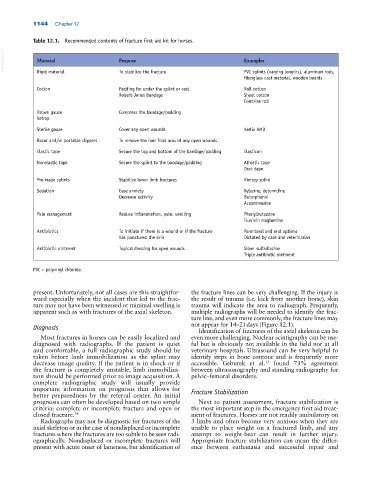Page 1178 - Adams and Stashak's Lameness in Horses, 7th Edition
P. 1178
1144 Chapter 12
Table 12.1. Recommended contents of fracture first aid kit for horses.
VetBooks.ir Material Purpose Examples
To stabilize the fracture
PVC splints (varying lengths), aluminum rods,
Rigid material
fiberglass cast material, wooden boards
Cotton Padding for under the splint or cast Roll cotton
Robert‐Jones bandage Sheet cotton
Combine roll
Brown gauze Compress the bandage/padding
Vetrap
Sterile gauze Cover any open wounds Kerlix AMD
Razor and/or portable clippers To remove the hair from around any open wounds
Elastic tape Secure the top and bottom of the bandage/padding Elasticon
Nonelastic tape Secure the splint to the bandage/padding Athletic tape
Duct tape
Pre‐made splints Stabilize lower limb fractures Kimzey splint
Sedation Ease anxiety Xylazine, detomidine
Decrease activity Butorphanol
Acepromazine
Pain management Reduce inflammation, pain, swelling Phenylbutazone
Flunixin meglumine
Antibiotics To initiate if there is a wound or if the fracture Parenteral and oral options
has punctured the skin Dictated by case and veterinarian
Antibiotic ointment Topical dressing for open wounds Silver sulfadiazine
Triple antibiotic ointment
PVC = polyvinyl chloride.
present. Unfortunately, not all cases are this straightfor the fracture lines can be very challenging. If the injury is
ward especially when the incident that led to the frac the result of trauma (i.e. kick from another horse), skin
ture may not have been witnessed or minimal swelling is trauma will indicate the area to radiograph. Frequently,
apparent such as with fractures of the axial skeleton. multiple radiographs will be needed to identify the frac
ture line, and even more commonly, the fracture lines may
Diagnosis not appear for 14–21 days (Figure 12.1).
Identification of fractures of the axial skeleton can be
Most fractures in horses can be easily localized and even more challenging. Nuclear scintigraphy can be use
diagnosed with radiographs. If the patient is quiet ful but is obviously not available in the field nor at all
and comfortable, a full radiographic study should be veterinary hospitals. Ultrasound can be very helpful to
taken before limb immobilization as the splint may identify steps in bone contour and is frequently more
15
decrease image quality. If the patient is in shock or if accessible. Geburek et al. found 73% agreement
the fracture is completely unstable, limb immobiliza between ultrasonography and standing radiography for
tion should be performed prior to image acquisition. A pelvic–femoral disorders.
complete radiographic study will usually provide
important information on prognosis that allows for Fracture Stabilization
better preparedness by the referral center. An initial
prognosis can often be developed based on two simple Next to patient assessment, fracture stabilization is
criteria: complete or incomplete fracture and open or the most important step in the emergency first aid treat
closed fracture. 36 ment of fractures. Horses are not readily ambulatory on
Radiographs may not be diagnostic for fractures of the 3 limbs and often become very anxious when they are
axial skeleton or in the case of nondisplaced or incomplete unable to place weight on a fractured limb, and any
fractures where the fractures are too subtle to be seen radi attempt to weight‐bear can result in further injury.
ographically. Nondisplaced or incomplete fractures will Appropriate fracture stabilization can mean the differ
present with acute onset of lameness, but identification of ence between euthanasia and successful repair and

